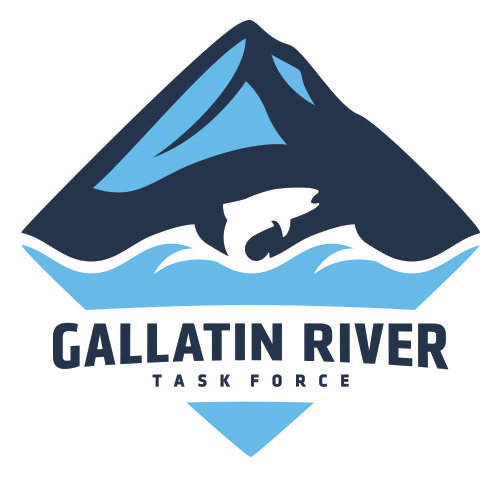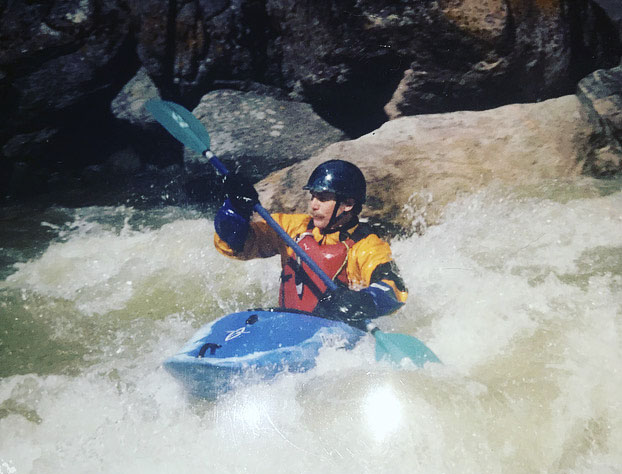David Quammen negotiating the Gallatin’s infamous Mad Mile. PHOTO COURTESY OF THE QUAMMENS.
The Task Force is nothing without our devoted Friends of the Gallatin. These members make up the our volunteer base, commit professional and financial support, and inspire us with their tireless stewardship of the Upper Gallatin Watershed. Recently, we touched base with the Quammens, checking in with Betsy and David on what river means to them.
Here’s what they had to say.
Why the Gallatin River Task Force? There are many worthy causes locally—what draws you to this work?
Betsy: We’re devoted conservationists and feel particularly drawn to the Gallatin River. The Task Force has a very different approach than other organizations. They are science based, but are magically capable of bringing divergent parties together on behalf of the Gallatin River. They keep the Gallatin healthy by ongoing monitoring, negotiating, and engagement.
David: I love rivers and have always loved rivers. Rivers are a large part of what brought me to Montana and has kept me here almost 50 years. Anyone who works for river conservation is a friend of mine, a hero of mine…but for the Gallatin in particular. My home, backyard river these past 40 years I’ve lived in the GYE.
How can individuals take more responsibility for their river use?
Betsy: Because we share the Gallatin, we need to be active in protecting it. This starts with giving generously to GRTF. The Gallatin attracts business and revenue to Big Sky and Bozeman. If you are benefiting from that, you better be sharing your profits with our primary river keeper. Give generously and listen to GRTF guidelines on septic issues, lawn care, erosion, and river bank cleanup!
David: Every tap we turn on, every dish we wash, every handle we flush, every sprinkler that greens our yard… it all puts demands on the water resources of the watershed in which we live. John Wesley Powell understood this before anyone and more clearly: the history of the American West, the fate of the American West, is a matter of watersheds. Water is finite. If you care about life in all its diversity, in the place where you live, then you’d better commit to the watershed, and inform yourself about, commit yourself to, its waters.
Describe a cherished memory from the Gallatin. Why do you think this river means so much to so many people?
Betsy: The Gallatin is where my every adventure begins. I have spent big summer chunks backpacking along its tributaries, passing through riotous wildflowers, and catching sight of moose, deer, elk, sheep, and even rubber boas. Each night out, I’m lulled by the sound of waters pouring from the Spanish Peaks and finding their way to the Gallatin.
David: During the 1980s and 1990s, intensively for 20 years, I was a passionate whitewater kayaker, and along with my best buddies, I spent many days, many evenings, running the Gallatin, usually from Moose Creek or Greek Creek down to somewhere below House Rock and the Mad Mile. We bonded on that river. We exhilarated. Sometimes, at very high water, we paddled virtually across the top of House Rock. We flipped and rolled. On a bad evening, someone swam. On a very bad evening, someone swam in high water and almost died. But none of us did. Those were some of the best hours of my life.
But amid all the adrenaline and excitement and exercise and splendid scenery and sinuses filled with Gallatin water, I remember one form of enjoyment especially. There was a particular spot, above the highway bridge, below Greek Creek, with a large cliff rock jutting out from the right, protecting a big eddy. I think perhaps we called that rock the Nose, or some such thing. Preceding it was a sizable wave train, during high water. Maybe also a boulder to avoid. The move was this: You dodged your boat around the boulder, you rode the wave train on a brace, you angled hard toward the Nose, you hit the eddy line with the correct lean on a strong Duffek stroke, and suddenly you were in quiet water, bobbing safely in the eddy.
The payoff was this: As you sat in that eddy, waiting for your friends to make the same move, whitewater rushing by, if it was the right time in spring, and you looked up on the rock wall on your right, the backside of the Nose, you saw an ouzel nest. You were on a living river. May it stay that way.


